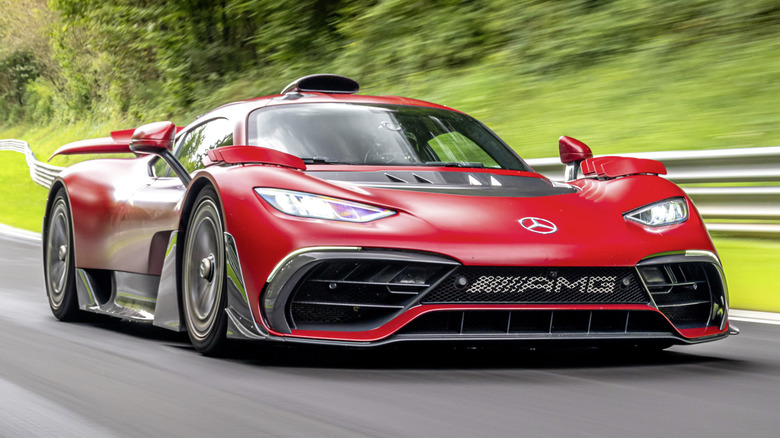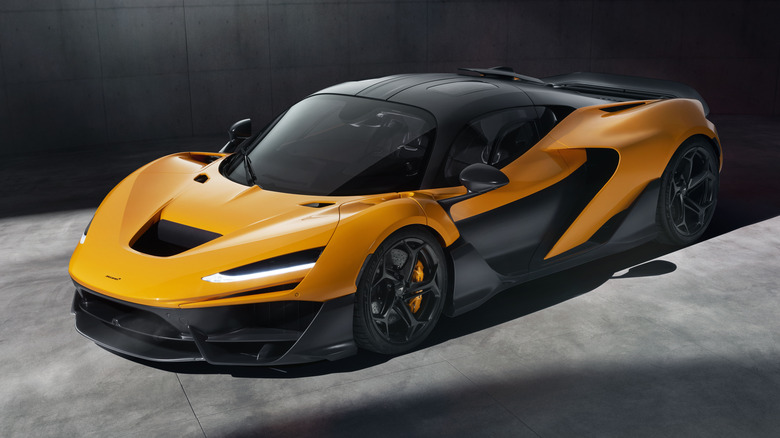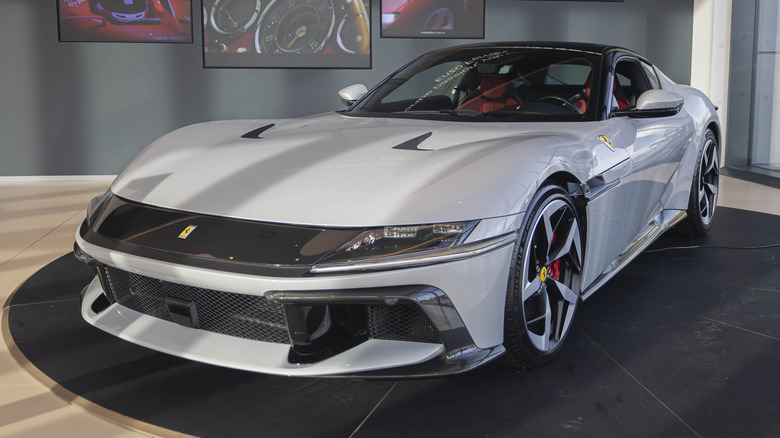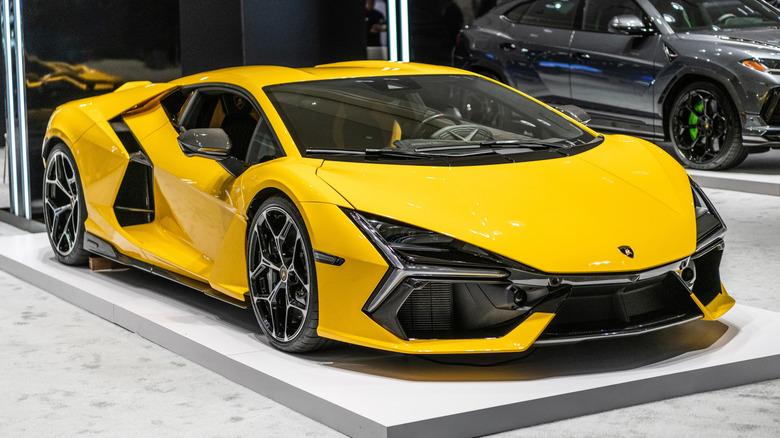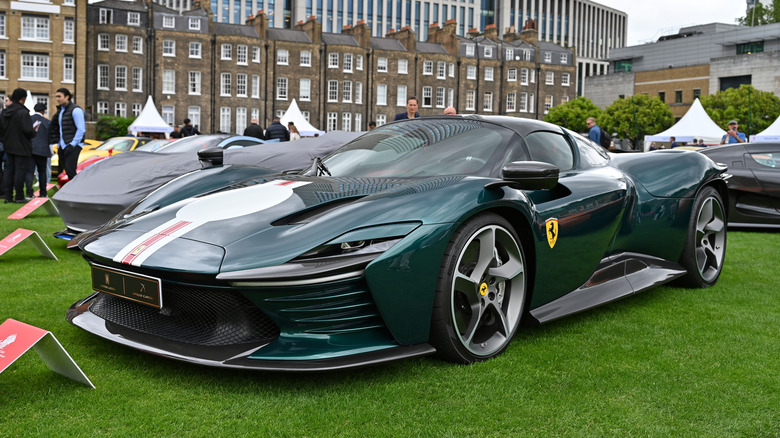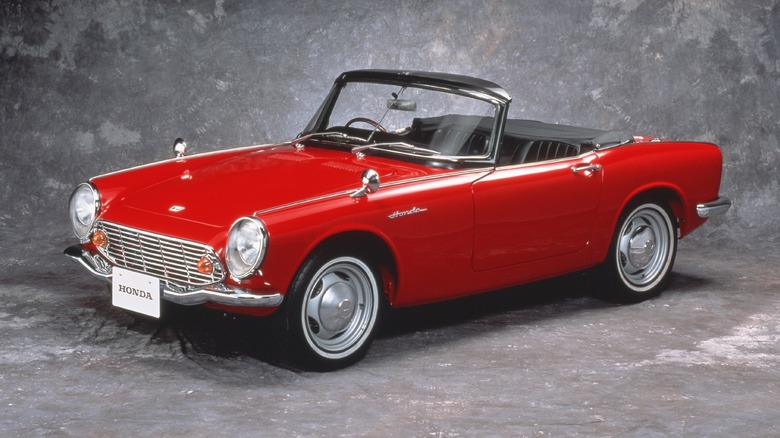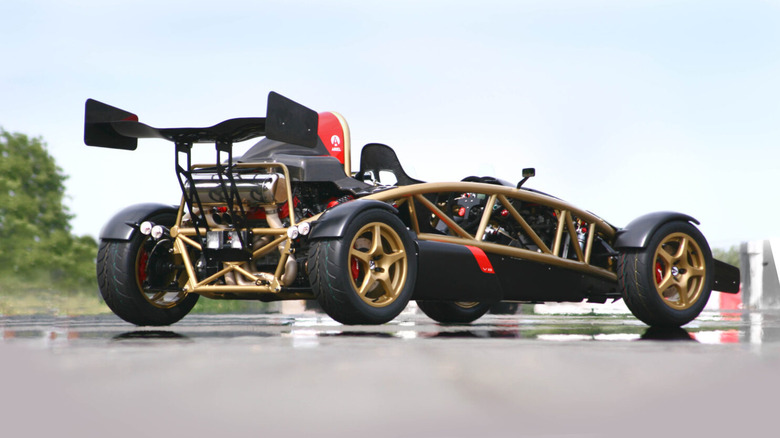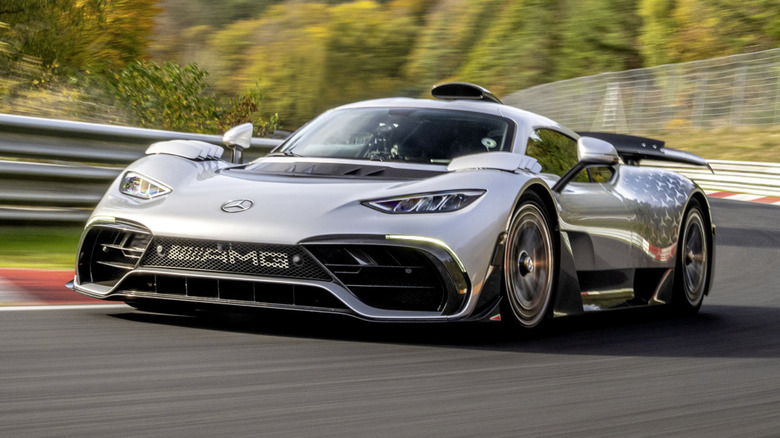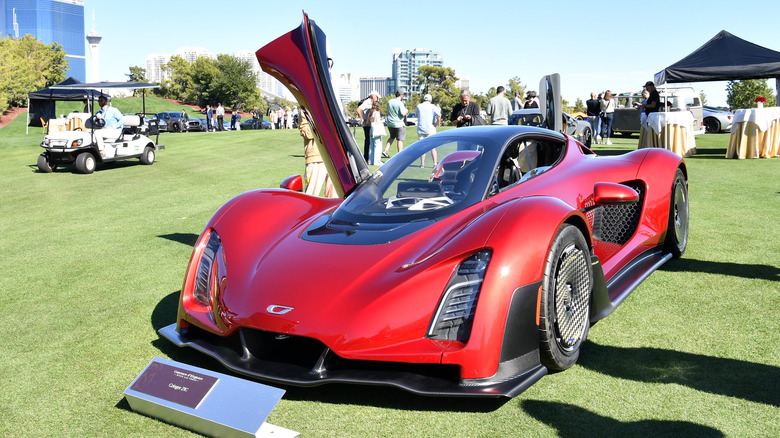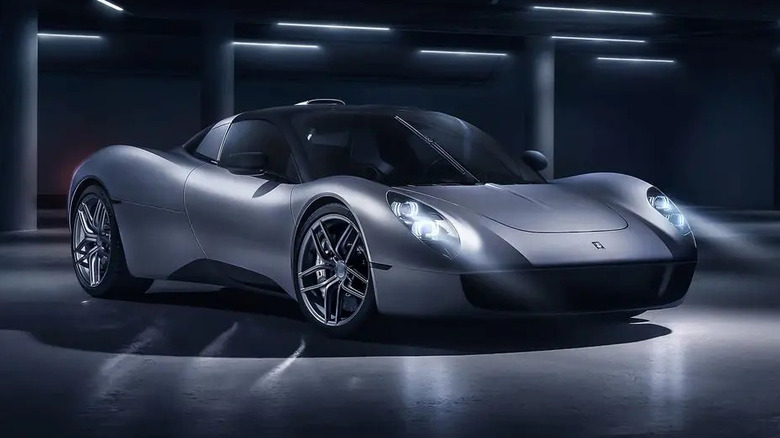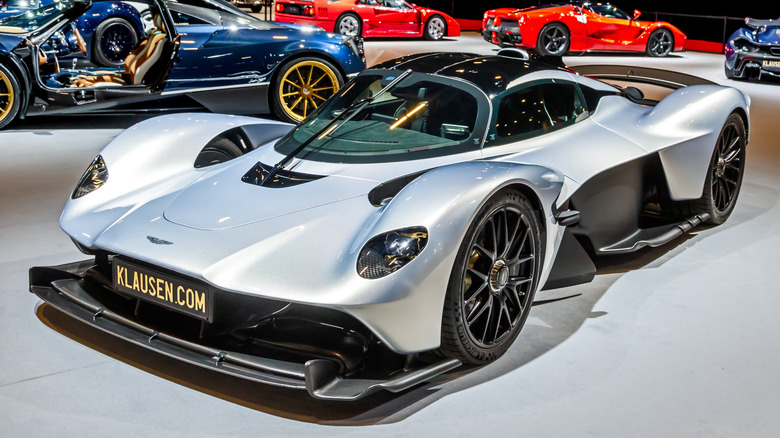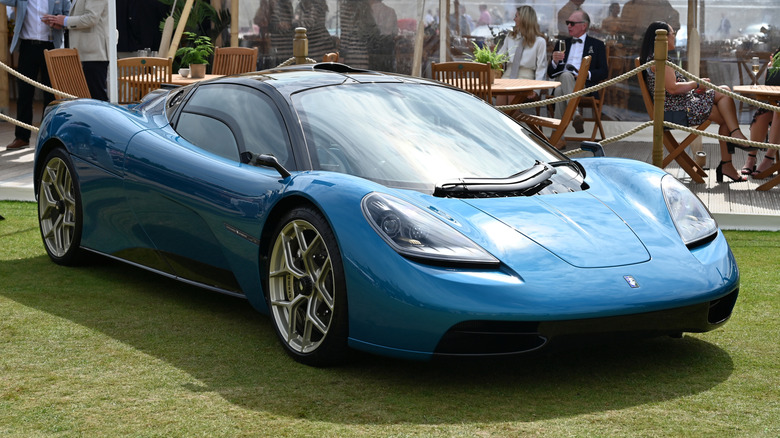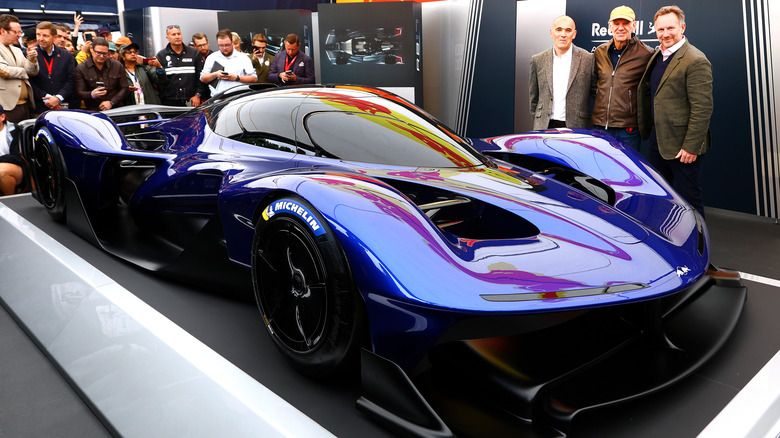12 Of The Highest-Revving Engines Ever Released In A Production Car
One of the key downsides of mass electrification in the auto industry is that the joy of pushing a car to its redline might one day be lost. Future enthusiasts might not be able to revel in the soundtrack of a combustion engine at its limit, be that a mighty V12, a thundering V8, or even a screaming rotary. However, that day is a long way away — longer than many enthusiasts might assume, in fact.
Performance car makers are continuing to push the boundaries of combustion engine performance, and with that comes ever-rising redlines. Some of the latest supercars and hypercars come with rpm limiters that many would have considered for race cars in decades past. While there are in fact a small number of older models that can rev just as high, most of the very highest revving cars have been unveiled in the last decade or so.
These 12 cars are all among the highest revving production cars ever built. Many are highly limited special editions, with production runs in triple or even double digit figures, and prices that are far out of reach for all but the wealthiest collectors.
McLaren W1 — 9,200 rpm
Unveiled in late 2024, the McLaren W1 is the latest iteration in the brand's legendary line of hypercars. It comes bearing a suitably long list of superlatives. It's the most powerful McLaren ever built, with 1,258 bhp on offer. It also boasts the best power-to-weight ratio of any McLaren supercar at 899 bhp per tonne. It's the fastest McLaren road car ever built, and can sprint from 0-186 mph in a little under 13 seconds. The British carmaker also calls the W1 its fastest-lapping road car ever, beating the Senna by several seconds per lap on its development track.
Under its carbon fiber bodywork sits a hybrid V8 powertrain, and much like the rest of the car, that V8 is an engineering triumph. McLaren quotes an official redline for the W1 at 9,200 rpm, enabled by the use of cutting-edge technologies like plasma spray coated cylinder bores. It's assisted by an electric motor that spins to 24,000 rpm, and borrows design elements from McLaren's IndyCar program.
Unsurprisingly, its F1 efforts also played a part in the design, most notably in the aero package that helps keep the car glued to the asphalt all the way up to its electronically limited top speed of 217 mph. Despite a price tag of over $2 million, all 399 planned examples of the car reportedly sold out before its public unveiling.
Ferrari 12Cilindri — 9,500 rpm
This next one is a chief example of how not every new supercar has been subject to electrification. The Ferrari 12Cilindri was unveiled in 2024 and sports a high-revving V12 under its hood, which churns out 819 bhp and screams its way to a redline of 9,500 rpm. It's designed to be the successor to the 812 Superfast, and as such, it's equally at home on the track or on the road.
Drivers willing to push its limits either on a closed circuit or particularly empty stretch of autobahn will find that the car's V12 revs even higher than the 812 Superfast, topping out at 9,500 rpm. Its top speed is somewhere north of 211 mph, although Ferrari hasn't given an exact figure. Unlike the aforementioned McLaren W1, the 12Cilindri isn't some ultra-limited model only available to the brand's most loyal clients. It's available in the U.S. for a reported $464,000 starting price, and while only the coupe is available at launch, a spider version is set to launch sometime in mid-2025.
Lamborghini Revuelto — 9,500 rpm
While Lamborghini's latest flagship supercar might be more approachable and versatile than ever, its underlying appeal hasn't changed. The Revuelto's appeal still centers around its dramatic design, sharp handling, and perhaps most importantly, the V12 engine at its heart. Only, it's now backed by some electrical assistance, helping the car to reach a combined 1,001 horsepower. More specifically, that assistance comes in the form of a trio of motors, with two motors delivering power to the front wheels and another motor linked to the transmission.
The V12 still steals the show, with a 9,500 rpm redline and the soundtrack that Lamborghini buyers have come to expect. It's also still as thirsty as other Raging Bulls, with the electric motors only making minimal improvements to its fuel efficiency. Anyone planning a longer journey to make full use of the car's many talents will need to accommodate plenty of fuel stops along the way.
Ferrari SP3 Daytona — 9,500 rpm
Before the 12Cilindri was unveiled, another Ferrari sported an even higher rev limit, although even most Ferrari owners will have never been able to sample it for themselves. The SP3 Daytona is one of limited-run cars in what the brand calls the Icona series, with 599 units built at a price of over $2 million each. The car was first unveiled in 2021, with deliveries for American customers commencing in 2023. The SP3 Daytona's chassis is derived from that of the LaFerrari Aperta, while its engine was adapted from the 812 Competizione.
That engine, an 828 horsepower V12, boasted a higher redline than the 812 Competizione thanks to new titanium connecting rods. It pushed the car's limiter to 9,500 rpm, with its peak horsepower coming just a few hundred rpm below that limit. Combine that groundbreaking power with the car's distinctive retro-modern styling and it's easy to see why buyers snapped it up despite its seven figure price tag. A reported 150 examples out of the 599 total run were allocated for American buyers, and all quickly sold out upon the car's unveiling.
Honda S600 — 9,500 rpm
Although it wasn't Honda's first production car, the S600 was the first to be sold overseas by the brand. Honda had already established itself as a motorcycle maker both at home in Japan and abroad, but nonetheless the S600 represented a significant milestone. It shared some motorcycle design elements, including its high-revving four-cylinder engine and chain drives to send power to the rear wheels, but this was in no uncertain terms a sports car.
It was a unique one to boot, with its 9,500 rpm redline giving it a soundtrack unlike any other car on the road at the time. It proved moderately successful abroad and highly successful in Japan, with around 11,000 examples of the car built in total. Only a small handful of those survive today, but even so, the S600 is still the most affordable way to bag a production car with an ultra-high revving engine. Examples sell for anywhere between $20,000 and $100,000 depending upon mileage and condition.
Ariel Atom 500 V8 — 10,600 rpm
As well as being one of the rarest cars here, the Ariel Atom 500 V8 is also one of the most unusual looking. The Atom might have been around for over a quarter of a century now, but time hasn't affected its ability to turn heads. It still looks like something that shouldn't be wearing a license plate, and in the case of the Atom 500, it sounds like it doesn't belong on the road to boot.
The engine responsible for the racket is a 3.0-liter V8 that was designed specifically for the Atom, and formed from two Suzuki Hayabusa engines. It sports a redline of 10,600 rpm — only a small margin short of where Hayabusa owners report that their motorcycles top out. The Atom 500 V8 is a lot cheaper than many of the other supercars and hypercars on this list, with a retail price at launch of around $200,000, but it is also rarer than nearly all of them. Over its exclusive production run, just 25 examples were built.
Mercedes-AMG One — 11,000 rpm
Taking the phrase "race car for the road" more literally than most other manufacturers dare, AMG's flagship hypercar project suffered from long development delays but eventually began deliveries in 2023. Part of the reason for those delays was the difficulty that engineers faced in making Mercedes' F1 technology, which had been integral to the car since the start of its development, road legal.
Among those F1-derived components is the car's 1.6-liter V6 engine, which sports an 11,000 rpm redline. That's not quite as high as the brand's race-spec F1 powerplant, but Mercedes claimed the lower limit was to preserve the engine's longevity and allow it to run on commercial grade gasoline.
Much like in F1, the V6 engine is assisted by a complex hybrid system that's designed to respond much faster than a standard supercar hybrid powertrain. The combined 1,063 hp output is enough to propel the Mercedes-AMG One to 62 mph from standstill in just 2.7 seconds, and to 186 mph in 15.6 seconds.
Czinger 21C — 11,000 rpm
Czinger is still a new entry to the hypercar world, having only been around since 2020. The 21C is the startup's debut model, and is limited to a maximum of 80 examples according to the brand. Hybrid hypercars with four-figure outputs are no longer groundbreaking, and so the 21C's performance figures shouldn't seem too outrageous: 1,233 bhp on offer from a 2.88-liter V8 hybrid powertrain, and a claimed 0-186 mph time of 15 seconds.
Dig a little deeper and things get more unusual. The V8 engine has reportedly been developed entirely in-house by Czinger, and it sports an 11,000 rpm redline. It's also flex-fuel compatible, according to the brand. Even more uniquely, the car uses 3D-printed components that have been designed and optimized by AI.
Despite its short time in operation, the brand has forged a dealership network that spans America, Europe, and Asia, with those dealers tasked with convincing buyers that spending a reported $2 million on the car is a worthy investment. Given the car's spacecraft-like looks and unique construction, that shouldn't be too difficult a task.
Gordon Murray Automotive T.33 — 11,100 rpm
First shown off in 2022, the T.33 is the second model to emerge from Gordon Murray's eponymous carmaking outfit after the T.50. While the T.50 was designed to a kind of spiritual successor to Murray's iconic McLaren F1 design, the T.33 is a clean-sheet supercar aimed at taking the best of modern and classic car design and combining them into one. Its exterior design features none of the aggressive lines or over-the-top aero seen on many contemporary supercars. Instead, cleaner, flowing lines give the car a more timeless look.
Underneath that elegant bodywork is a revised variant of the Cosworth-developed V12 engine that first appeared in the T.50 hypercar. This time around, its redline is reduced slightly to 11,100 rpm, and 607 hp is available for drivers to play with. The car's production run was capped at 100 units, with a reported list price of around $1.85 million, and each one quickly sold out after the car's unveiling.
Aston Martin Valkyrie — 11,100 rpm
Cosworth has been busy over the last few years. The renowned British outfit has been building V12 engines for a variety of high profile projects, including the aforementioned Gordon Murray supercars and for the Aston Martin Valkyrie. The latter's engine is referred to as the RA, and is 6.5 liters in displacement with a redline of 11,100 rpm. Despite its similarity to the Gordon Murray Cosworth engine, there's no connection between the two.
In the Valkyrie, the V12 is assisted by electric motors to generate a combined 1,160 bhp. The electric elements of the powertrain were sourced from Rimac and Integral Powertrain, while the overall design was shaped with the help of Red Bull Advanced Technologies. Combining all this expertise into one finished car was no small feat, and one that took Aston Martin a much longer time and many more millions of investment dollars than the company was expecting. Still, investors' loss was Valkyrie owners' — and hypercar fans' — gain.
Gordon Murray Automotive T.50 — 12,100 rpm
The highest revving production car able to wear a licence plate as of this writing is the Gordon Murray Automotive T.50, which boasts a Cosworth-built V12 engine with a 12,100 rpm redline. Designed with a central driving position, the T.50 also features a fan for added downforce, like Murray's most famous car, the McLaren F1. The T.50 is arguably the most direct successor to the F1, even more so than McLaren's own more recent halo series hypercars.
The whole car also only weighs just under 2,200 pounds, making its 650 hp enough to reach a claimed theoretical top speed north of 270 mph. The price of admission is predictably steep — around $3.2 million — but even if you've got deep enough pockets to consider such a purchase, you're out of luck. Every one of the 100 planned examples has already been allocated to buyers, both of the T.50 and of the track-oriented T.50s.
Red Bull RB17 — 15,000rpm
The hypercar with the highest revving engine unveiled to date is the Red Bull RB17, although it comes with an asterisk. Red Bull revealed the car at the 2024 Goodwood Festival of Speed, detailing its 1,200 hp V10 powertrain, 15,000 rpm redline, and sub-2,000 pound curb weight. However, it isn't road legal — at least, it isn't designed to be. Designer Adrian Newey, also behind the Aston Martin Valkyrie, intends the RB17 to be the ultimate track car, capable of delivering F1-level lap times.
However, this is unlikely to remain the case. British engineering specialist Lazante, notable for its work in converting cars like the McLaren F1 GTR and P1 GTR for road use, confirmed to Top Gear that it plans to launch a conversion program for the RB17. According to Lazante, several RB17 buyers had reached out to the company shortly after its Goodwood reveal, with the program set to commence as soon as those customers receive their allotted cars. For now, the GMA T.50 remains the highest-revving production car that can wear a license plate, but it looks likely that it won't retain that crown for too much longer.
